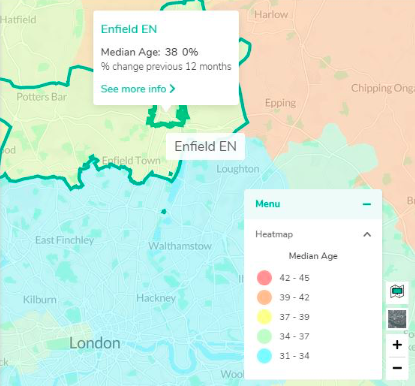The number of people leaving the capital hit a 10-year high in 2017, with 292,000 people deciding that they had enough of the Big Smoke. With much talk of London affordability and sizing-up opportunities in the suburbs, are we seeing a resurgence of commuter towns? We use the REalyse platform to take a closer look.
Read Time: 5 minutes
When you hear the words ‘commuter town’, images of areas not too far from London will likely pop into your head. While there are commuter towns close to big cities across the whole of the UK, it’s the spiralling house pricesin the capital that have made the need for commuter towns near London so popular.
Over the last 10 years, people have been flocking in their droves from the capital and laying down roots in more affordable towns, creatingsome attractive opportunitiesfor property investors and developers alike. Lower living costs look appealing for those residing in London, where the average house price is just shy of half a million pounds.
But is it merely a case of lower house prices, or are there other factors at play for the resurgence of commuter towns?
Commuter Towns: A History
A commuter town is defined as ‘a populated area with residents who normally work elsewhere, but in which they live, eat and sleep’, according to the folks at Wikipedia. And it’s a fair assessment, too – commuter towns usually serve a primary purpose that is transport related. So proximity to the big cities is key.
Many of these commuter hubs were developed as part of the New Towns Movement. Though they came into play shortly after the Second World War, the reasons weren’t specifically because of house prices back then. London suffered heavily from bomb attacks during the war, and many homes were destroyed as a result.
The destruction left people in the capital with nowhere to live. Consequently, towns such as Stevenage, in Hertfordshire, and Crawley, in West Sussex, are the direct result of the New Towns Movement. Today, the core use of these towns is for people who work in London, but who can’t afford the premium that comes with living in the capital.
Leaving London
The amount of people leaving London and moving to a commuter town is growing. Over the last decade, 550,000 more Brits left London than moved to it. In 2017, the number of people leaving the capital hit a 10-year high, with 292,000 peopledeciding that they had enough of the Big Smoke.
Millennials make up a large proportion of people leaving London. The age range consists of people in their 20s and 30s, with the Office of National Statistics (ONS) reporting that 26% and 23% of people from these age groups left London in 2015.
The last few years have not been any different, with London losing around 30,000 people aged between 25 and 34 in 2016 and 2017. Those aged between 20 and 35 are more likely to be first-time buyers who look to commuter towns for more affordable deals.
Where Is Everybody?
All those people leaving the capital need to go somewhere. While not everyone leaving London goes to a commuter town, a significant proportion of them do. A quick Google search for ‘best commuter towns’currently brings up 4.3 million results, which indicates the high popularity of the topic.
There are many factors at play for why people choose specific commuter towns, but the main two are commute times and property prices. Cheshunt, in the county of Hertfordshire, is currently rated as the best commuter town to London, according to Totally Money.
Looking at the Cheshunt postcode on REalyse’s heatmaps, the rumours are true: the average age in the commuter town is 38, suggesting that the exodus of younger people from London to is indeed occurring, with millenials looking to find their feet on the property ladder further afield. With only a 30 minute train journey to London Liverpool Street, Cheshunt looks like a viable alternative. But is there more to it than that?
Using the REalyse database to look at Cheshunt (EN8) as an alternative to a more central residential area of London such as, say, Hampstead (NW3), it is easy to see the reasons for these commuter towns becoming that much more enticing for Generation Rent in particular. Let’s start by comparing the median prices paid in the two postcodes:

With median property prices in NW3 almost triple the price of those in EN8, it isn’t surprising that most residents in the NW3 area are tenants and only 37% are property owners. Meanwhile in EN8, however, 66% of residents are homeowners.
This has much to do with mortgage availability. For a single person looking to buy a one-bedroom flat, the mean monthly mortgage repayment they can expect to pay out of their income is 40%. Well, that is closer to CEO’s Gav Merkado’s recent definition of affordable, and it is certainly more appealing than mortgage affordability in Hampstead, taking a whopping 91% of average monthly income in the NW3 area.
Not every single commuter can live in Cheshunt, though. Plus, if you follow the trail, the majority of people try and stay as close as financially possible to their London postcode. North London residents often find themselves heading to towns in Hertfordshire; people from South London usually move to Surrey, Sussex and Kent; East London residents typically end up in Essex; and West Londoners head to Hampshire or Berkshire.
The Future of Commuter Towns
While property prices in the capital have slowed in pace, the premiums are so high that it looks like moving to a commuter town will be a trend for a good while. With technology and transport improving, it’s likely that towns even further away from London will grow in popularity.
The Elizabeth Line (formally the Crossrail), will go as far out as Reading to the west and Brentwood to the east, perhaps inviting a greater movement of people out of London as they look for more affordable residences. The rise of remote workingalso means that living in London for work-related reasons no longer holds the importance that it once did.
The number of new developments is also increasing in commuter towns as developers identify opportunities to build housing that meets the growing demand. In fact, if you’re a developer, looking away from the capital for opportunities could prove to be a savvy move.
The words ‘commuter town’ might just be music to your ears.








